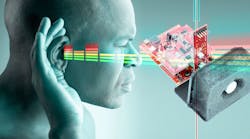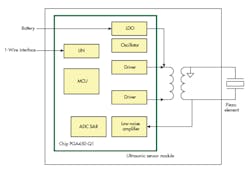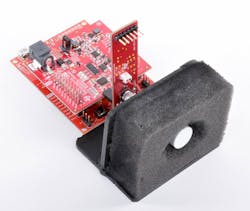Ultrasonic Sensors: A Smart Choice for Shorter-Range Applications
Download this article in PDF format.
Ultrasonics refers to signals that are above the human hearing span (>20 kHz), and usually in the 40- to 70-kHz range. These signals are used like radar—they’re radiated toward a target and reflected back to the source. They are low cost, flexible, and especially useful in shorter-range applications, especially automotive, home, and industrial robotic designs.
Ultrasonic sensors are sometimes joined by microwave/mmWave radar and video cameras to provide different but complementary views of their surroundings in automotive and industrial applications. If you’re looking for a sensor that can not only detect the presence of a target, but also tell you how far away it is, ultrasonics may be a good choice for you.
Sponsored Resources:
- Use Ultrasonic sensing for graceful robots
- Ultrasonic Sensor Interface IC for Park Assist or Blind Spot Detection Systems
- Industrial robotics overview
Ultrasonic Applications
Ultrasonics has found its way into a wide range of applications, the largest sectors probably being proximity detection and range measurement. Others include liquid-level detection in tanks, flow-measurement systems, and imaging products. Most of the newer applications address the consumer electronics, automotive, and industrial/robotics fields. Those are the focus of this article.
Consumer Electronics
Home owners want to automate their homes these days. Thermostat and lighting controls are the most popular, but other conveniences are ceiling fans, video doorbells, garage-door openers, and security alarms. All of these can probably be improved by adding some form of proximity detection. This allows lights to be automatically turned on or off, heating and air conditioning to be adjusted based upon occupancy, and security alerts.
Another potential application is proximity detection for the popular voice-activation/response hubs like Amazon Alexa, Google Home, Apple HomePod, and others. These devices could sleep and conserve power if no one is nearby, but could wake up if presence is detected.
A current popular application is robotic vacuums—machines that automatically vacuum your floors. Most use ultrasonics to navigate around objects that are successfully detected by ultrasonic transducers. Multiple transducers give these devices a full 360-degree view, allowing them to easily navigate even the most complex rooms.
Ultrasonic sensing is a low-cost, slower-speed alternative to radar for robots that don’t need to reach high speeds in homes. Ultrasonic sensing is also more reliable than optical time-of-flight for obstacle avoidance, as ultrasonic sensing isn’t affected by the amount of available light reflected off of obstacles. Some applications have also shown ultrasonics to be superior to passive-infrared (PIR) sensors that can be fooled by animals and even insects.
Automotive
Ultrasonics is ideal for some automotive applications. It’s now used for blind-spot detection and self-parking in modern advanced driver-assistance systems (ADAS). And it has found a place in the popular kick-to-open trunk/tailgate feature on many new SUVs. These sensors are small enough and modestly priced making them a good choice for new users.
Industrial
Automation by robots is a growing trend in manufacturing and other industrial applications. They move materials around on the factory floor. They pick up and place objects as needed in assembly operations. One important concern is collisions between robots or between robots and humans. That’s where proximity detection steps in to prevent such accidents—ultrasonic sensors are well-suited to handle this task. They give robots an additional level of intelligence that helps them do their materials-handling jobs without incident.
The Ultrasonic Ranging Concept
As mentioned, ultrasound signals refer to those above the human hearing range, roughly from 30 to 480 kHz. For ultrasonic sensing, the most widely used range is 40 to 70 kHz. The frequency determines range and resolution; the lower frequencies produce the greatest sensing range. At 58 kHz, a commonly used frequency, the measurement resolution is one centimeter (cm), and range is up to 11 meters. At 300 kHz, the resolution can be as low as one millimeter; however, range suffers at this frequency with a maximum of about 30 cm.
An ultrasonic transceiver radiates a signal by way of a piezoelectric transducer. When that signal strikes a target, a reflection signal is produced. That signal is received at the transceiver, which measures the time of transmission and return. Then using the speed of sound in air, the distance D is computed.
The speed of sound in free space, given in feet per second, is 1120. This value varies with temperature and other surrounding factors, but is a good average value to use for range calculation.
D is the total round trip of the ultrasonic signal, and T is the time in seconds for transmission and reception. The round-trip distance then is:
D = 1120 (T)
The actual distance between the transceiver and the remote target is one half of D.
Example: Ultrasonic Sensor Interface for Automotive Applications
A good illustration of an ultrasonic system is one for park assist or blind-spot detection. It’s available as the TIDA-00151 reference design from Texas Instruments. The reference contains the company’s PGA450-Q1 IC, which is a system-on-chip (SoC) sensor interface IC for automotive ultrasonic sensors. It provides the entire signal conditioning and processing for the transducer echo signals and for calculating the distance between the transducer and objects. The MCU (8051 core) and program memory allow for full configurability for the specific end application. A Local Interconnection Network (LIN) serial interface connects this subsystem to other systems in the vehicle.
1. At the heart of this automotive ultrasonic sensor system is TI’s PGA450-Q1 chip, which contains most of what is needed in most applications. It supports sensors in the 40- to 70-kHz range. (Courtesy of Texas Instruments)
Figure 1 shows the chip in an ultrasonic module. A transformer is used to connect to the ultrasonic piezoelectric transducer to provide sufficient transmit power. The same transducer is used as the receiver. An on-chip LDO allows for connection directly to the automotive battery for dc power.
A complete ultrasonic sensor module is shown in Figure 2. This is the PGA460 SoC that provides for object detection at distances as low as 5 cm and as high as 11 m. It can accommodate a range of frequencies from 30-70 kHz or 180-480 kHz, allowing system designers to achieve better resolution and shorter distance detection.
2. Shown is an ultrasonic sensing module featuring a Murata transducer and the TI PGA450-Q1 IC.
The PGA460 integrates a low-noise amplifier (LNA) that maximizes performance in noisy environments and helps maintain accuracy. With the ability to operate in low-power mode at 300 µA, the PGA460 is adaptable to many different end-equipment designs, reducing power consumption in battery-powered personal electronics, and increasing accuracy in automotive park assist and landing assist in unmanned vehicles.
Industrial Robotics Design
TI also offers robotics subsystem reference designs for engineers to add new features and capabilities to their next-generation robot designs. One of these is the TIDA-01386. The module reference design uses the PGA460 SoC similar to the PGA450-Q1 described earlier. It can work at 58 kHz or 300 kHz, depending on the range and resolution needs of the robot. The chip includes an embedded version of the MSP430 MCU but with DSP capability. An IO-Link interface connects to the outside world.
Sponsored Resources:



